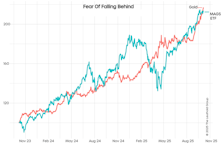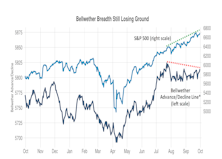Inside The Stock Market ...trends, cross-currents, and outlook
S&P 500 Goes Streaking
The index’s monthly win streak looked as dead as Disco as November progressed. Then, SPX rallied to close the month with its best five-day run since mid-May to attain a 7th consecutive monthly win. In the majority of prior cases, the index proceeded to post above average results for the next three- and six-month periods.
The Life Of A Bull
As we tickle the October high, the present bull has already achieved something quite special. This iteration has posted the largest price gain (+93%) of any bull market that wasn’t born in a recession.
Wellness Month
Whenever the market’s thematic leadership hits an air pocket, it is instructive to discover where investor interest shifts. In November, those evacuating big tech found refuge in the Health Care sector, which staged a remarkable comeback from its extended weakness this summer.
Don’t Stop Believin’... In Fed Liquidity
While stretched valuations in AI-related names were widely cited as the trigger for the mid-November stock market hiccup, a more convincing explanation lies in the plumbing of the financial system.
Our Most Contrarian Group Ideas
Contrarian investing is difficult; from both an emotional and implementation standpoint, but our disciplined industry-scoring process periodically endorses segments that glaringly conflict with consensus (and our own) views. When an industry at odds with the conventional narrative materializes as highly-rated, it often turns out to be one of our more successful portfolio allocations.
The Downside Of A Two-Time Hook-Up
In late September, our Very Long Term Momentum algorithm reversed higher after being on a downward track since 2024. There have been just ten other cases of this since 1957, and it has often been a stock market trap. Not an official signal, but worth watching.
The Illusion Of Breadth
S&P 500 performance is being propelled by its disproportionate concentration in the Magnificent Seven stocks, while the Russell 2000’s leadership is powered by unprofitable small caps, thereby resulting in breadth of quantity, not quality.
A Reason For The Season?
November ushers in a tropical breeze for risk-seeking investors. The six-month stretch from November through April has proven to be an exceptionally profitable time, particularly for those exposed to factors, such as size, value, and volatility.
What All-Time High? A Value And Quality Perspective
As AI-growth heavyweights keep pushing the S&P 500 to new all-time highs, value investors have been completely left out. Usually, buying high-quality value names is the best defense, but that has been a disaster in the current cycle. Junky value is substantially outpacing quality value.
The Year Of AANA?
The return landscape has been good for a passive “own-everything” asset allocation policy. Our hypothetical “All Asset No Authority” (AANA) portfolio has seen a few more cylinders firing this year. In fact, YTD, none of AANA’s asset class constituents have negative performance.
FOMO—With A Twist
FOMO is in full gear and—unlike the meme-stock mania of 2021—it’s been underpinned by an extremely compelling storyline: The seemingly limitless possibilities of artificial intelligence.
Bellwether Boost
Officially, as of September 30th, five of our eight bellwethers have confirmed the latest S&P 500 high. That’s typically good enough for the boat to stay afloat—and looks healthier than at February’s high.
Deviation Beneath The “Bells”
While our traditional breadth and leadership studies advise the market is quite healthy, we’ve lately observed some broader disagreement from long-term leaders, including the Magnificent Seven—of which only two have made new 52-week highs over the last month.
Aging Bull Tracking A Post-Recessionary Young’un
We’re in the third upleg of a cyclical bull market that began at full employment, yet this rally is tracking the path of a bull market that launched in the aftermath of a recessionary bear market bottom.
Fed Rate Cuts And Equity Tilts
Interest-rate cycles driven by Fed-policy changes can be the most powerful determinants of economic and market conditions. Decisions to raise or lower the fed funds rate impact sectors and styles differently; September’s rate cut prompted us to review equity winners and losers from prior episodes.
Late Summer Heat Wave
A Fed that’s been incapable of controlling the intensity of the flame will soon be supplying it with more oxygen in an attempt to stimulate real activity. The odds are that any new fuel on the fire will find its way into consumer prices, long before it stimulates “unit growth” in slumping sectors.
Old Worries, New Highs
After a springtime scare, the stock market has shrugged off more than its fair share of troubles. We offer some quick observations on a range of topics, including our stance on the bull market and historical comparisons, IPO and speculative activity, equity leadership, and the economy/interest rates/inflation.
Abandoning 2%
The Fed has been neither correct nor anticipatory for an extended period of time. Ironically, if a September rate cut were followed by a decline into recession later this year, the Fed may be hailed as both correct and anticipatory—and some semblance of Fed independence could be maintained.
Unintended Consequences?
There are unmistakable parallels between September’s likely Fed rate cut and the initial lowering of rates preceding the GFC. In each case, despite leading inflation gauges still trending up, a housing slump and deteriorating labor market served to justify the move. In 2007, after the Fed cut, measures of real growth failed to respond and inflation, in fact, shot higher.
Checking In On The Bellwethers
Not only is the stock market no more expensive than in February, but it’s also looking internally more healthy. At the February 19th high, seven of the eight bellwethers were waving warning flags versus just four today.




















